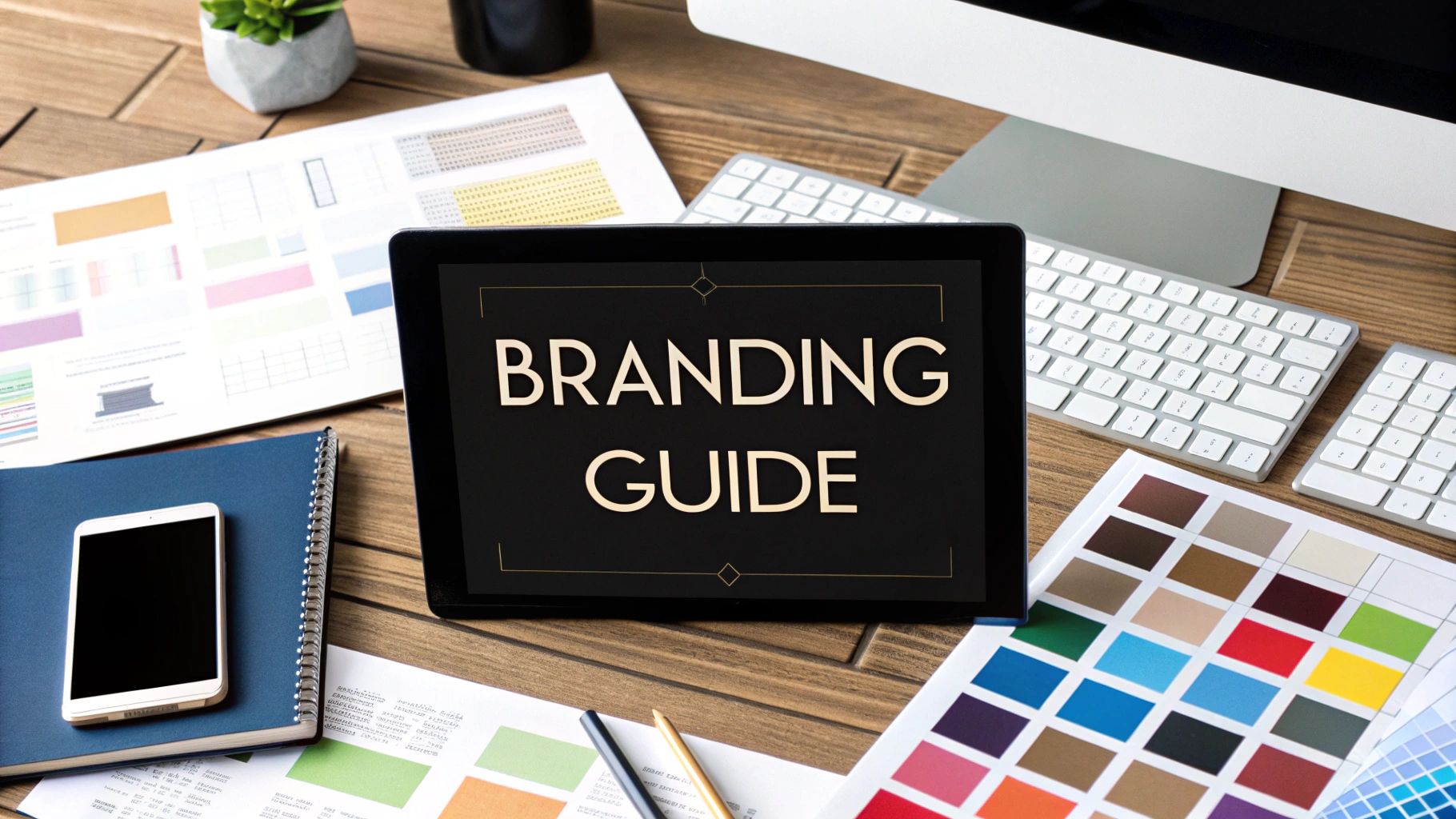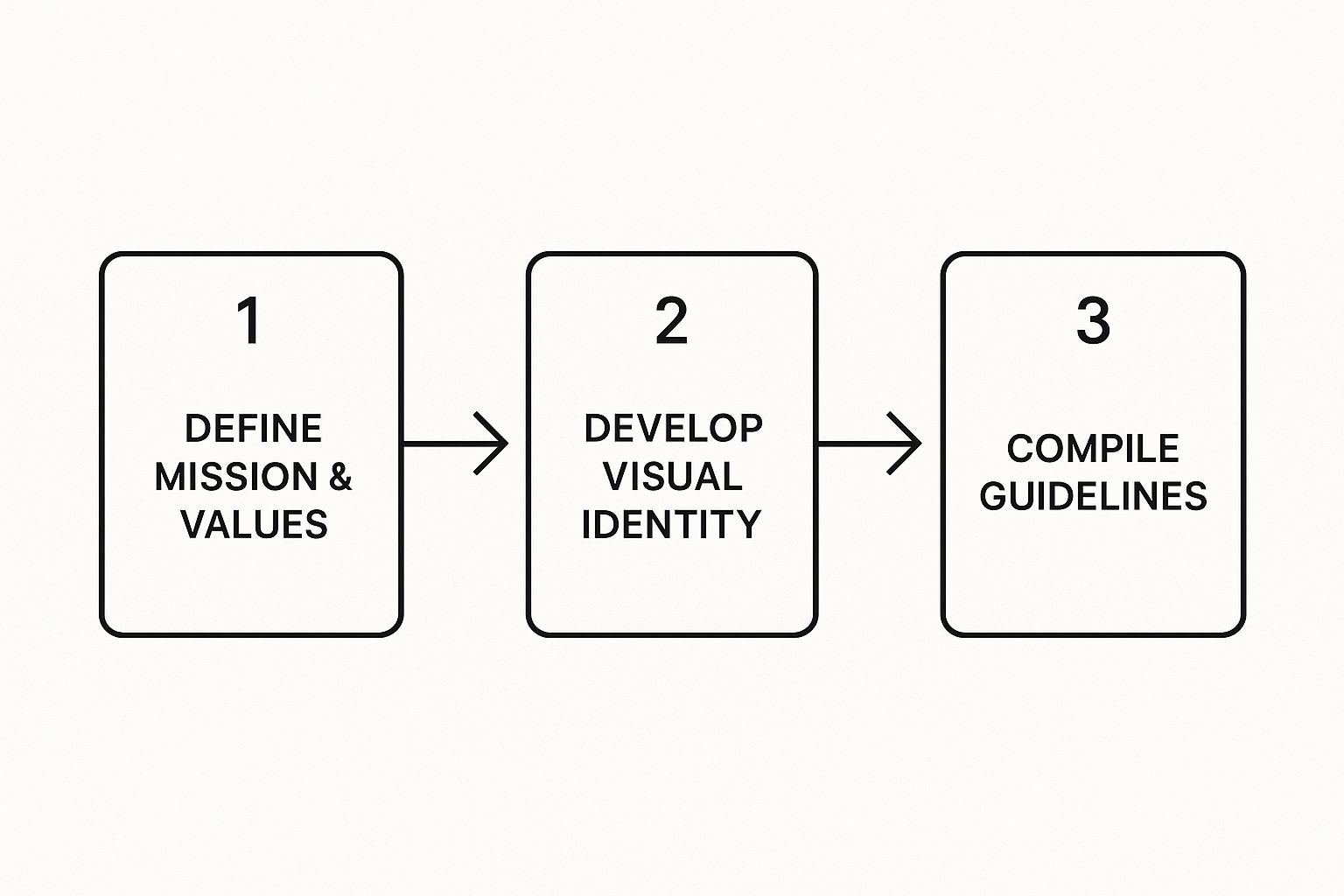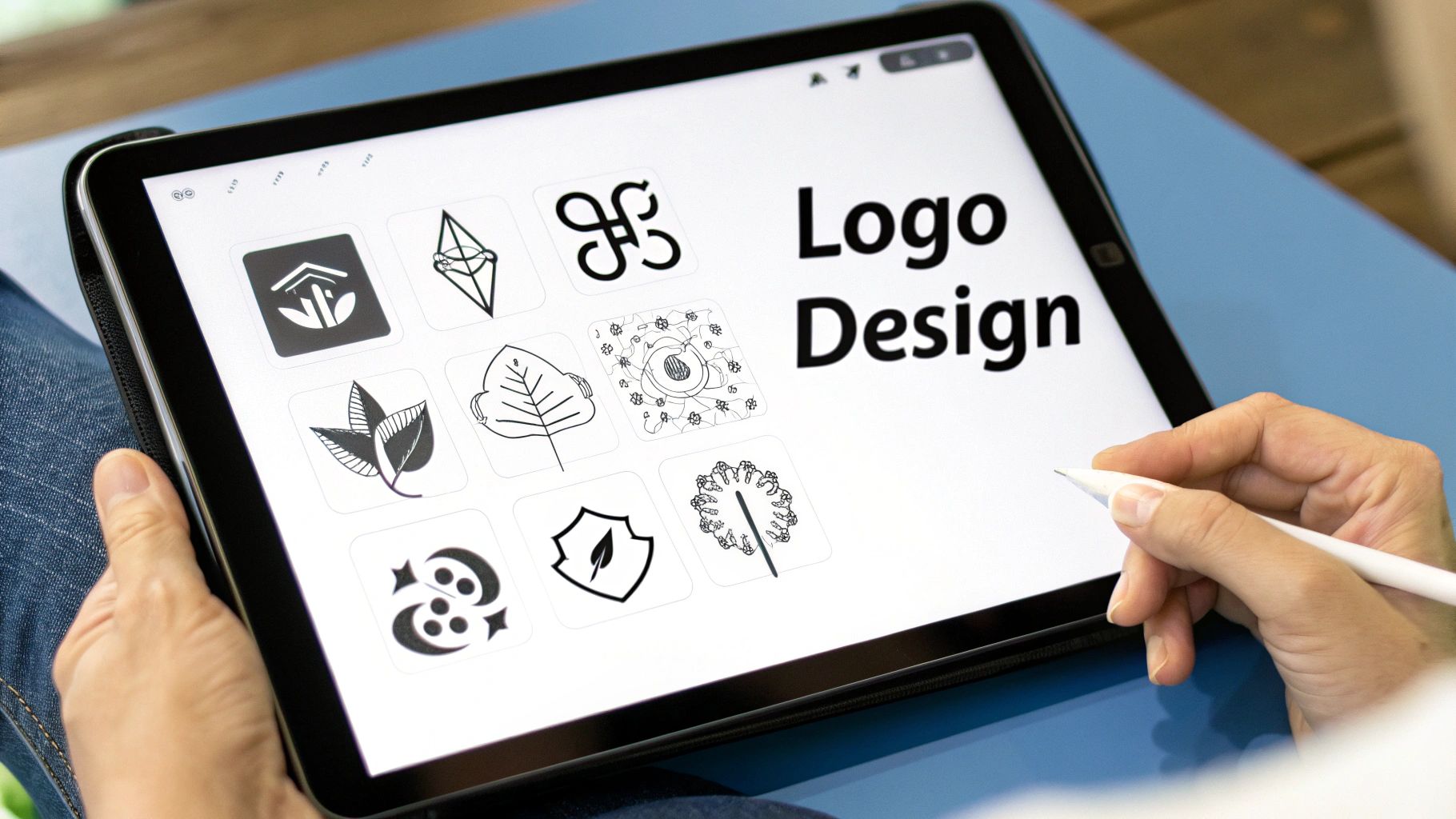How to Create a Branding Guide That Works
Learn how to create a branding guide that builds consistency. Get actionable steps for defining your visual identity, brand voice, and real-world application.

So, you're ready to build a branding guide. The whole process really boils down to three key stages: figuring out your brand's core mission and values, crafting its visual identity, and then gathering all those rules into one go-to document. This isn't just about making things look pretty; it's about making sure every single thing you put out there—from a billboard ad to a quick social media post—feels like it comes from the same brand.
Your Quick Guide to Brand Consistency
A branding guide, which you might also hear called a brand book or style guide, is basically the "single source of truth" for your company's identity. It’s so much more than a list of rules. It’s a powerful tool that gets everyone on the same page, whether they're in marketing, sales, or product design. Without it, your message can get messy and inconsistent, leaving customers confused and weakening your brand's impact.
Think of it like a team playbook. When a new designer comes on board, they don't have to guess which color hex codes or fonts to use—it's all right there. When a writer needs to draft an email, they have clear instructions on the right voice and tone. That kind of consistency is what builds brand recognition and, more importantly, trust. In fact, research shows that a consistent brand presentation can boost revenue by up to 20%, yet so many companies struggle to actually enforce their own rules.
The Blueprint for Your Brand
Creating a truly effective branding guide is a structured process, not just a burst of creative energy. Each step logically builds on the one before it, making sure the final document is comprehensive but also genuinely useful for day-to-day work.
You can see this workflow in action here:

This visual makes it clear that a killer visual identity doesn't mean much if it isn't built on a solid foundation—your brand's "why." The final guide is the result of smart, strategic thinking, not just pretty design choices. For those building a presence in the creator economy, the tools for AI influencers and branding show just how deep this a brand's identity can go in today's world.
Key Takeaway: Your brand guide isn't a static PDF you create once and forget about. It's a living document that turns your big-picture strategy into clear, practical instructions for your entire team.
To get started, it helps to break the process down into its core components. This table outlines the essential stages and what you should aim to achieve in each one.
Core Components of a Branding Guide
| Stage | Core Focus | Key Elements | Desired Outcome |
|---|---|---|---|
| Foundation | Defining "Why" | Mission, Vision, Values, Target Audience | A clear strategic direction for all brand activities. |
| Visual Identity | Defining How Brand Looks | Logo, Colors, Typography, Imagery, Iconography | A cohesive and recognizable visual system. |
| Voice & Tone | Defining How Brand Sounds | Personality, Voice Chart, Grammar Rules, Vocabulary | A consistent and authentic communication style. |
| Application | Showing in Practice | Mockups, Real-World Examples, Dos & Don'ts | Practical guidance for applying brand assets correctly. |
Mapping out these areas gives you a solid framework. With this structure, you can ensure that you cover all your bases, from high-level strategy to the nitty-gritty details of execution.
Defining Your Brand’s Foundation and Audience

Before you even start thinking about logos, fonts, or color palettes, you need to lay the groundwork. The brands that truly resonate—the ones that last—are built on a rock-solid foundation of purpose and a deep, authentic understanding of who they exist to serve. This is the strategic heart of your entire branding guide.
Jumping straight into design without this foundational work is like building a house without a blueprint. It might look passable from the outside, but it won’t be stable, functional, or built to last. Your brand's foundation is the compass that guides every single decision you'll make down the line.
Uncovering Your Brand’s Purpose
Your brand's core purpose isn't just about what you sell. It's the "why" that fuels your business. To really pin this down, you need to articulate three key pillars:
- Mission Statement: This is the what, who, and how of your business right now. Think of it as a clear, concise declaration of your day-to-day purpose. For instance, a mission could be: "To provide small businesses with intuitive software that simplifies their accounting."
- Vision Statement: This is your north star—your big, audacious goal for the future. It’s aspirational and paints a picture of the impact you want to have on the world. An example might be: "A world where every entrepreneur can manage their finances with confidence."
- Core Values: These are the non-negotiable principles guiding every decision and action your company takes. Values like "Innovation," "Customer-Centricity," and "Integrity" can’t just be words on a wall; they have to show up in how you operate every day.
The best way to nail these down is to get your key stakeholders in a room for a workshop. Ask the tough questions: "What problem do we solve that no one else does?" or "If our brand were a person, what would they be like?" This process helps you move beyond generic corporate-speak and uncover what truly makes you unique.
A strong brand foundation isn't just for an internal document. It becomes the guiding light for your marketing, product development, and customer service, ensuring everyone is pulling in the same direction.
The financial power of a clearly defined brand is staggering. In 2025, the total value of the world's top 500 brands skyrocketed to nearly USD 9.5 trillion—a 10% jump from the previous year. This growth proves just how much a strong brand identity is worth, especially when a comprehensive branding guide ensures that message stays consistent across different markets. This is why your guide must account for local nuances in language and culture to stay relevant globally. You can dive into the details in the full 2025 brand value report.
Getting to Know Your Audience
Once you've defined who you are, the next critical piece of the puzzle is defining who you're talking to. You can't be everything to everyone. Trying to appeal to the masses will only dilute your message and make you forgettable. This is where creating detailed customer personas is a game-changer.
A persona is essentially a semi-fictional character sketch of your ideal customer, built from market research and real data you have on your existing audience.
Don’t be afraid to get specific. Give your persona a name, a job, goals, and, most importantly, pain points. What keeps them up at night? What are they trying to accomplish in their life or work? For example, a persona you call "Freelance Fiona" might be struggling with inconsistent income. Suddenly, you have a powerful angle for your marketing content that speaks directly to her reality.
This deep understanding shapes everything from your brand's voice to your visual style. If you want some strategic insights on how founders name brands, it's worth exploring different naming approaches that align with the specific audience you're trying to reach.
Building Your Visual Identity System

With a solid brand strategy in place, you can now start giving it a face. This is the exciting part where your brand’s personality becomes something people can actually see and feel. We're talking about building a visual identity—a complete system that ensures your brand looks like your brand, every single time.
Think of it this way: whether someone spots you on a billboard, an app icon, or a quick Instagram story, the experience should feel connected and instantly familiar. Your goal is to create a versatile toolkit that anyone, from your in-house marketing team to a freelance designer, can use to bring your brand to life correctly.
Crafting Your Color Palette
Color is your brand's silent communicator. It’s one of the first things people notice, and the right choices can make a massive impact. In fact, research shows that a signature color can boost brand recognition by up to 80%. Your palette should be a direct extension of your brand's personality, not just a collection of colors you like.
When building your palette, think in layers:
- Primary Colors: These are your workhorses, the one-to-three colors that will appear most often. They need to capture the core emotion you want people to associate with your brand.
- Secondary Colors: Think of these as your supporting cast. They complement your primary colors and are perfect for accents, buttons, or highlighting information.
- Neutrals: Never underestimate the power of black, white, and gray. They provide breathing room, improve readability for text, and ground your design.
For every color you choose, your guide must list its specific color codes—HEX for web, RGB for screens, and CMYK for anything printed. This eliminates guesswork and keeps your brand looking consistent across every medium.
Selecting Typography That Speaks Volumes
The fonts you choose say a lot about you before anyone reads a single word. Typography is your brand's voice made visible. A classic serif font can project tradition and authority, while a clean sans-serif often feels more modern and approachable. The right choice can completely change how your message lands.
To keep it consistent, your brand guide needs a clear typographic hierarchy:
- Primary Typeface: This is your hero font, used for headlines and big statements. It should be distinctive and dripping with personality.
- Secondary Typeface: This font is all about readability. It's for body copy and longer text, so it needs to be clear and easy on the eyes, no matter the size.
- Usage Rules: Define the specific sizes, weights (like bold or regular), and spacing for everything—from your main headings (H1, H2, H3) down to tiny captions.
This structure is what separates professional-looking content from amateurish chaos. If you're looking for inspiration, it's always a good idea to check out other https://createinfluencers.com/guides to see how established companies organize their typography.
The payoff for this consistency is huge. Companies that keep their branding consistent can see revenue jump by 10-20%. And yet, while 95% of businesses have brand guidelines, only about a quarter of them actually enforce them. That's a massive missed opportunity. You can find more stats on the impact of branding at ExplodingTopics.com.
A well-defined visual identity is more than just a collection of assets; it’s a system that empowers your team to create consistently excellent work. The table below breaks down the key components and why they matter.
Comparing Key Visual Identity Elements
| Element | Best Practice | Strategic Impact | Common Mistake to Avoid |
|---|---|---|---|
| Color Palette | Define primary, secondary, and neutral colors with specific HEX, RGB, and CMYK codes. | Evokes emotion and boosts brand recognition instantly. | Choosing too many colors, leading to a chaotic and unprofessional look. |
| Typography | Establish a clear hierarchy with a primary (headline) and secondary (body) typeface, including size and weight rules. | Shapes the brand's personality and ensures readability across all communications. | Using fonts that are hard to read or don't match the brand's intended tone. |
| Logo Usage | Provide clear rules for spacing, minimum size, and approved variations (e.g., monochrome, reversed). | Protects the brand's most recognizable asset, ensuring it's always clear and impactful. | Allowing the logo to be stretched, recolored, or placed on busy, illegible backgrounds. |
Ultimately, each of these elements works together to create a unified and memorable brand experience. Getting them right is fundamental to building a strong visual presence.
Defining Logo Usage and Variations
Your logo is the cornerstone of your visual identity, so you have to protect it. Your brand guide is the place to set crystal-clear rules on how your logo should—and should not—be used. Without these guardrails, logos get stretched, squashed, recolored, or lost on cluttered backgrounds, which weakens your brand.
Your guide should be explicit and visual. Include the following:
- Primary Logo: The main, full-color version that should be used most of the time.
- Variations: Offer one-color and reversed-out (white) versions for tricky backgrounds.
- Clear Space: Specify a "safe zone" of empty space that must be maintained around the logo.
- Minimum Size: Define the absolute smallest the logo can be shown while still being legible.
- Incorrect Usage: This is crucial. Show visual examples of what not to do, like changing the colors, altering proportions, or adding cheesy effects like drop shadows.
By building a complete visual identity system, you're not just making a rulebook. You're creating a scalable framework that gives your team the confidence and clarity to build on-brand materials quickly and effectively.
Crafting a Memorable Brand Voice and Tone

If your visuals are how your brand looks, your voice is how it sounds. It's the unique personality that comes through in every piece of communication, from a formal proposal to a casual social media reply. A well-defined brand voice transforms a faceless company into a relatable personality that people genuinely want to connect with.
This goes far beyond just picking a few vague adjectives like "friendly" or "professional." To really nail your brand voice, you need to dig deeper. The aim is to create a practical framework that empowers everyone on your team—whether they're a senior copywriter or a brand-new customer support agent—to communicate with one consistent, recognizable personality.
Voice is Your Personality, Tone is Your Mood
It's a common mistake to use "voice" and "tone" interchangeably, but they play distinct roles. Here’s a simple way to think about it: your brand voice is your core personality—it's fixed. Your tone is the emotional inflection you apply to that voice in different situations.
Your voice is who you are, always. Are you the wise mentor, the witty sidekick, or the encouraging coach? That never changes. Your tone, however, must adapt. You wouldn't use a celebratory, high-five tone when responding to a customer complaint, just as you wouldn't sound somber and overly serious when announcing an exciting new feature.
One of the most effective ways I've seen this documented is with a simple voice chart. It turns abstract ideas into clear, actionable guidance.
Here's a quick look at how you can translate voice characteristics into practical dos and don'ts for your team.
| Voice Characteristic | What This Means | Do This | Don't Do This |
|---|---|---|---|
| Witty & Playful | We use clever humor and wordplay to make our audience smile. | "Our new feature just dropped. Go on, give it a whirl." | "We are pleased to announce the release of a new feature." |
| Clear & Direct | We get straight to the point without jargon or fluff. | "Get started in 3 easy steps." | "Begin the onboarding process by following these procedures." |
| Empathetic & Supportive | We show genuine care and understanding, especially when issues arise. | "We're so sorry you're running into this issue. Let's get it fixed." | "Your ticket has been received. Please await a response." |
A simple chart like this is a game-changer. It gives everyone, regardless of their role, a clear roadmap for how to write and speak like your brand.
Building Your Brand Vocabulary
Beyond the overarching personality, your guide needs to get specific about the actual words you use. This covers everything from key messaging points to the nitty-gritty of which terms to use and which to avoid completely. This is how you build a distinct verbal identity.
Make sure your guide includes:
- Key Messaging & Taglines: Lock in your primary taglines and unique selling propositions so they appear consistently everywhere.
- Preferred Terminology: Do you have "users," "clients," or "members"? Are they "customers" or "partners"? Define these to keep everyone on the same page.
- Words to Avoid: Create a blacklist of overused industry jargon, competitor-owned terms, or negative words that don't align with your brand's vibe.
This verbal toolkit makes your brand's character feel solid and real.
Authenticity in communication is non-negotiable for building trust. Today's marketplace demands that branding guides move beyond visuals and articulate how a brand's voice connects with audiences.
With 81% of consumers needing to trust a brand before they open their wallets, your voice is often the first and most important tool for building that relationship. It's not just about customers, either. Employer branding is a huge piece of the puzzle, especially when you consider that 65% of consumers say a brand’s CEO and employees influence their buying decisions. Your brand guide must equip every single person to be an authentic brand ambassador. You can learn more about how these trends are shaping strategy by exploring the rise of authentic global marketing in 2025.
Showing Your Voice in Action
Finally, don't just tell—show. The best brand guides bring the voice and tone guidelines to life with real-world examples. This helps your team see how the rules work in practice across different channels.
Consider breaking this section down by communication type:
- Social Media Posts: Draft a sample tweet, an Instagram caption, and a LinkedIn update that perfectly nail your brand's personality.
- Customer Support Emails: Write two sample responses—one for a happy customer inquiry and another for a frustrated one. This is perfect for showing how tone shifts while the core voice stays the same.
- Website Copy: Pull a short paragraph from your "About Us" page or a product description to serve as the gold standard for your web content.
Providing these clear, contextual examples removes all the guesswork. Your team won't have to wonder what "witty and playful" sounds like in an email; they'll have a perfect example to reference, making it infinitely easier to create on-brand communications that truly connect.
Putting Your Brand Guide to Work
A brand guide that just sits on a server gathering digital dust is a massive missed opportunity. Its real value only comes to life when your team actively uses it to shape every single piece of content, design, and communication you put out into the world. This is the moment your brand stops being a set of abstract rules and becomes a living, breathing entity.
The goal here isn't to lock down creativity with a rigid set of laws. Far from it. A great brand guide should act as a framework that empowers everyone—your internal team, freelancers, and agency partners—to create high-quality, on-brand work with confidence. It’s all about making brand consistency the path of least resistance.
Weave it into Your Daily Workflows
For your guide to have any real impact, it needs to be woven directly into the fabric of your team's daily routines. If it's a pain to find or a nightmare to use, people just won't bother. Accessibility and integration are everything.
Here’s how to make your brand guide an indispensable tool that people actually use:
- Make It Easy to Find: Store your guide in a central, cloud-based spot everyone can get to. Think a company intranet, a shared Google Drive folder, or even a dedicated channel in Slack. A static PDF buried five folders deep just won’t get used. Period.
- Make It Part of Onboarding: Your brand guide should be a cornerstone of the onboarding process for every single new hire, not just designers or marketers. This ensures everyone from sales to support understands and embodies the brand from day one.
- Link It in Every Creative Brief: Every new project brief—whether it’s for a landing page, a social media campaign, or a sales deck—needs a direct link to the brand guide. This small step makes referencing it a standard part of kicking off any project.
When you're ready to build your guide, using the right tools can make all the difference. Exploring resources like Notion Brand Guideline templates can help you create an interactive, easy-to-share document that your team will actually want to open.
Train Your People (and Your Partners)
You can't just email a link to the guide and expect everyone to absorb it through osmosis. You have to actively show people how to use it. This small investment of time upfront pays off massively in long-term brand consistency.
Once the guide is ready, hold a launch meeting or a hands-on workshop. Walk through each section, but more importantly, explain the why behind the rules and show practical examples of what to do (and what not to do). Make it interactive and give people plenty of chances to ask questions.
This step is even more critical when you're working with freelancers or outside agencies.
- For Freelancers: Make reviewing the brand guide a mandatory first step before they write a single word or design a single pixel. It’s even helpful to create a condensed "quick start" version for them that covers the absolute essentials.
- For Agencies: Schedule a dedicated brand immersion session. This helps them get a feel for the soul of your brand, not just the rules. The result is work that feels far more authentic and impactful.
My Takeaway: Your brand guide is a tool for empowerment, not enforcement. When people understand the strategic thinking behind the guidelines, they're much more likely to embrace them as a helpful creative compass rather than a restrictive set of rules.
A Real-World Test: The Landing Page Redesign
Let's walk through a common scenario to see how this all works in a real project. Imagine your team is tasked with redesigning a key landing page.
Without a brand guide, the process can easily descend into chaos. The designer might grab a trendy font they saw on another site, the copywriter might adopt a super formal tone, and the final result feels like it was built by three different companies. It's disjointed.
Now, let's replay that scenario with a brand guide bringing order and consistency to the process.
| Project Stage | Before the Guide (The "Wild West") | After Applying the Guide (A Cohesive Vision) |
|---|---|---|
| Typography | The headline uses a random font that isn't part of the brand's system, creating a visual disconnect. | The designer uses the specified primary and secondary typefaces and follows the typographic hierarchy perfectly. |
| Color | The call-to-action button uses a shade of blue that clashes with the brand's primary palette. | The primary brand color is used for the main call-to-action, creating a clear and consistent visual focus. |
| Copywriting | The copy is flat and filled with corporate jargon, failing to connect with the reader. | The copywriter consults the voice and tone section, rewriting the copy to be clear, direct, and empathetic. |
| Imagery | The stock photo feels generic and disconnected from the brand's established visual style. | The team selects a photo from the approved library that aligns with the defined imagery style (e.g., candid shots of real customers). |
| Logo Usage | The logo is crammed into a corner without proper clear space, diminishing its impact. | The logo is placed with the correct clear space around it, ensuring it stands out and isn't crowded by other elements. |
The final landing page isn't just more professional and visually appealing; it feels undeniably like your brand. Every element works together to tell a cohesive story. This is what reinforces brand recognition and builds trust with your audience from the moment they arrive. This is the real power of putting your brand guide into action.
Common Branding Pitfalls and How to Avoid Them
Look, even the most beautifully designed branding guide can end up gathering digital dust if your team doesn't actually use it. The finish line isn't creating the document; it's getting everyone to treat it as a living, breathing part of their daily work. This is where a lot of brands stumble.
One of the biggest mistakes I see is creating guidelines that are way too restrictive. When you lock everything down with rigid rules, you can completely suffocate creativity. Your team starts to feel like they’re working in a straitjacket, and innovation grinds to a halt.
Think of your brand guide as a compass, not a cage. It’s meant to give direction, not to put a stop to creative thinking.
Balancing Consistency with Creativity
So, how do you fix this? The key is to focus on principles over prescriptions. Instead of demanding a single, unchangeable template for every social media graphic, you could provide a flexible grid system. Show them clear examples of on-brand imagery and voice, and then trust them to work within that framework.
This approach empowers your team to innovate while staying true to the brand.
Here are a few ways to strike that balance:
- Show, Don't Just Tell: Instead of one "perfect" example, provide a handful of "good" examples. This shows versatility and possibility.
- Explain the "Why": People are much more likely to follow a guideline when they understand the strategy behind it. Don't just give a rule; explain the reason.
- Encourage Smart Experiments: Carve out some space for your team to test new ideas that still honor the brand's core DNA.
The real goal here is to build a culture of brand stewardship, where everyone feels a sense of ownership. When your team sees the guide as a tool that genuinely makes their work better and easier, they'll actually want to use it.
When Guidelines Are Just Ignored
Of course, the other massive problem is when the guide is simply ignored. This usually happens for a few predictable reasons: it’s impossible to find, it’s a pain to understand, or no one ever bothered to introduce it properly. A brand guide buried three folders deep on a server is completely useless.
To prevent this, you have to weave your branding guide into your team's everyday workflow. Make it a standard part of project kick-offs, onboarding for new hires, and every single creative brief. For more advice on building a strong brand culture and sidestepping common marketing mistakes, you should check out the insights on the CreateInfluencers blog.
Don't forget that celebrating great on-brand work and offering gentle reminders goes a long way in boosting adoption.
Ultimately, your branding guide can't be static. It has to evolve as your business does. Set a reminder to review it annually. This is your chance to update guidelines, swap in fresh examples, and cut out anything that's become outdated. This keeps your brand dynamic and connected, turning those potential pitfalls into real opportunities to make your identity even stronger.
Answering Your Brand Guide Questions
Even with the best plan, real-world questions always pop up when you're in the trenches building and using a brand guide. I get asked about this stuff all the time, so let's tackle a few of the most common hurdles you might encounter.
How Often Should I Update My Brand Guide?
Think of your brand guide as a living, breathing part of your company, not a dusty rulebook you create once and forget. I always recommend a formal, deep-dive review at least annually. This is your chance to audit everything, swap out old examples, and make sure the guidelines still line up with your business goals.
That said, don't wait for the annual review if something important changes. Did you just launch a new product? Did you pivot your core messaging? Update the guide right away. The goal is to keep it a single source of truth that your team can always rely on.
My Take: The worst brand guide is an outdated one. An annual review is non-negotiable, but stay agile and make updates the moment they're needed.
What are the Best Tools for Sharing and Hosting Brand Guides?
The best tool is the one your team will actually open and use. A simple PDF is classic, but let's be honest—it gets outdated the second you email it. Today, you'll get way more mileage out of a dynamic, cloud-based home for your brand.
Here are a few options I've seen work really well:
- For flexibility: Tools like Notion or Milanote are brilliant. They let you build beautiful, interactive guides that are a breeze to update on the fly. You can embed fonts, link to assets, and keep everything in one place.
- For serious asset management: If you're on a larger team, a Digital Asset Management (DAM) system like Bynder or Canto is a game-changer. These platforms house your guidelines right alongside a searchable, tagged library of every approved logo, photo, and template.
- For company-wide access: Sometimes the simplest solution is the best. A dedicated, easy-to-find section on your company's internal network or intranet can work wonders.
No matter what you choose, the priority is making it dead simple for people to find what they need, when they need it.
How Do I Actually Measure the ROI of Being “Brand Consistent”?
This is the big question, isn't it? It can feel a little fuzzy, but you can absolutely track the impact of brand consistency. You just have to look at the right metrics.
Focus on the numbers that a strong, recognizable brand directly influences. Start by tracking brand recognition metrics—things like the amount of traffic that comes directly to your website (people typing your URL) or the volume of searches for your company's name.
You can also get direct feedback. Survey your customers about brand trust and loyalty. You’ll often find that as consistency improves, customer retention and positive sentiment follow suit.
Ready to create stunning visuals that live up to your new brand guide? With CreateInfluencers, you can generate unique, on-brand AI models and imagery in minutes, ensuring your content is always consistent and captivating. Start creating for free and bring your brand vision to life.